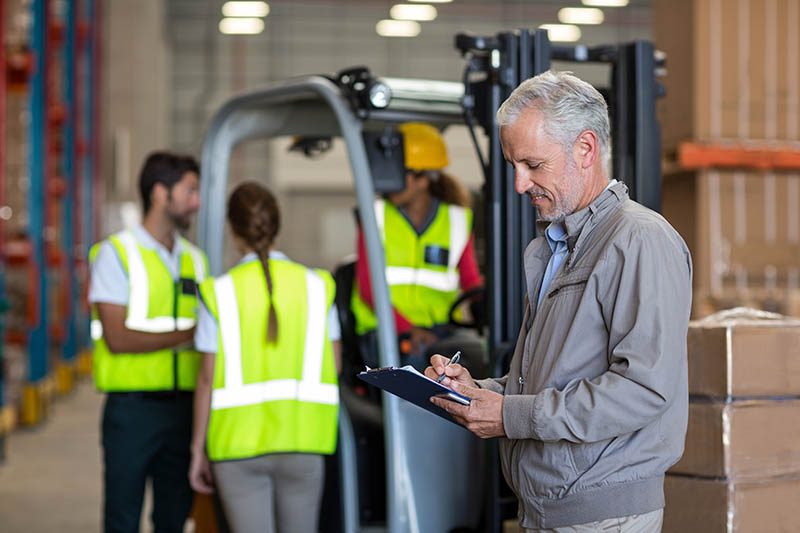
Within warehouses, ports, airports, depots and other such facilities, forklift drivers play a crucial role in moving heavy goods around. To be eligible for this pivotal role, it's essential to have a valid forklift certification. If you're considering roles like these, understanding the steps to obtain a forklift licence is not just useful, but a significant step towards a rewarding career. In this article, we delve into what forklift certification is, how to obtain forklift certification in the UK, and address some frequently asked questions.
What is forklift certification?
A forklift certificate demonstrates that you're capable of operating a forklift, which is a certificate that you receive after you've passed the necessary theoretical and practical tests and is proof of your competency.
The Health and Safety Executive (HSE) is the regulatory body for this type of work and sets the standards for forklift training. It also approves accrediting organisations that can accredit training providers. Another name for a forklift certificate is a forklift licence.
The Health and Safety Executive (HSE) does not require a license to operate a forklift in the UK, but you do need to complete training to comply with safe working practices. The HSE does encourage the use of certificates of training issued by an ATP (or AI/RI) to demonstrate that training has been provided.
What are the minimum requirements for forklift training?
The requirements to be eligible for forklift training are relatively few. The first is that you're of school-leaving age, so you could be as young as 17 when you train. It's important to note that in many jobs they might still require you to be at least 18. Regarding your health, it's important that your hearing is sufficient for hearing instructions and warnings and that you have full use of your limbs. If you have vision impairments, it's necessary to wear your glasses or contact lenses whenever you're operating a forklift.
Do you need a normal driving license for forklift certification training?
No. This is a separate type of vehicle and it's not necessary to have a standard driving licence to participate in forklift training. It's important to remember that you can drive many forklifts on the road, in which case a driving licence is going to be necessary. For this reason, some employers may ask for a driving licence to be eligible for the job.
Here are six steps to becoming a forklift operator
1. Choose the Forklift Type
As you mentioned, the first step is deciding which type of forklift you want to operate. Common forklift types include:
Counterbalance Forklifts (widely used in warehouses and logistics)
Reach Forklifts (ideal for narrow aisles in warehouses)
Telescopic Forklifts (commonly used in construction and agriculture)
Cherry Pickers (used for elevated work in maintenance or construction)
2. Find a Training Provider
Look for a reputable training provider accredited by an official body like:
Association of Industrial Truck Trainers (AITT)
Construction Industry Training Board (CITB)
National Plant Operators Registration Scheme Ltd (NPORS)
Road Transport Industry Training Board (RTITB)
Independent Training Standards Scheme and Register (ITSSAR)
3. Complete the Training Course
The training typically includes both theory and practical elements. The course duration depends on your prior experience:
Novice Course: Typically 3-5 days.
Experienced but Uncertified: 1-2 days.
Refresher Course: 1 day.
4. Pass the Theory and Practical Tests
The length of the training varies depending on how fast you learn, who the operator is and how many people are learning together, as forklift training is often group-based. In some cases, employers might arrange to have the training on-site so that newly trained employees are already familiar with the environment. In most cases, the average time to complete the training is three to five days. Most training providers will indicate how long on their websites, so it can be a good idea to check so that you can make yourself available.
Theory Test: Covers safety regulations, forklift operation principles, and legal responsibilities.
Practical Test: Demonstrating your skills in operating the specific type of forklift.
5. Receive Your Certification
Upon passing, you’ll receive a certificate or license that qualifies you to operate that specific type of forklift. The certification is typically valid for 3-5 years, after which you’ll need to complete a refresher course.
6. Apply for Jobs
Once certified, you can apply for forklift operator jobs in industries relevant to the type of forklift you’ve trained on.
Cost and Requirements
Cost: Training fees vary, typically ranging from £150 to £1000, depending on the course and provider.
Age Requirement: You must be at least 18 years old.
Health: A reasonable level of physical fitness and good eyesight are usually required. Some employers may request a medical examination.